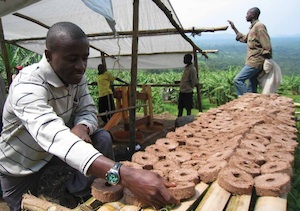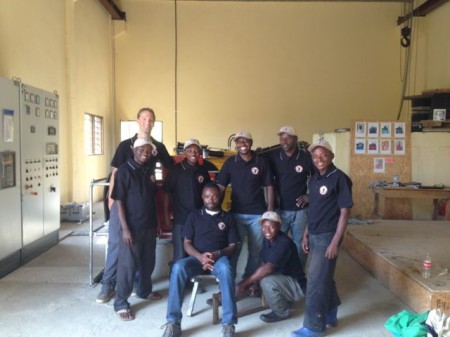Green energies to preserve a World Heritage site
Virunga National Park está situado en el corazón del conflicto, y extiende a ambos lados de la frontera entre la República Democrática del Congo, Ruanda y Uganda. El hogar de algunos de los últimos gorilas de montaña que quedan en el mundo,es el primer parque nacional de África, a World Heritage Site and is known to contain more species ofmammals, aves y reptiles que cualquier otra área protegida en el planeta.
Tras el genocidio de Ruanda, 15 años de conflicto violento en el este de Congo producen una de las peores tragedias en la historia reciente Humanitaria. El conflicto por los recursos naturales es la causa subyacente de los conflictos armados. El tráfico ilegal de los recursos forestales, en particular, carbón de leña, provided armed groups with one of their primary sources of income. Encima 70,000 tons of charcoal is illegallyproduced every year. Thisrepresents the destruction ofover 15,000 hectares of tropicalhardwood forest.
Producción de briquetas:
una fuente alternativa de combustible alrededor de Virunga
La 2008 study of the charcoal market in Goma by the African Conservation Fund estimated that 59,000 tonnes were consumed each year, with 80% coming from Virunga.
In these circumstances, the Village Briquette Factories project provided a viable solution to replace the consumption of charcoal in the region with a viable and sustainable alternative, evitando así la destrucción masiva de los bosques de Virunga. Combustible biomass briquettes are an ecologically sustainable fuel source available to households living in extreme poverty. They aresignificantly cheaper than charcoal and can be produced from a verywide range of abundant resources including grass, leaves, agriculturalwaste, sawdust and recycled paper.
The expected impact of the project should be of 34,000 sustainable employments. Kits completos de fábrica, que consiste en el equipamiento necesario, capacitación, apoyo y compra garantizada de la producción se dará a 5,000 equipos de 6 personas. Productoras de briquetas pueden generar suficientes ingresos para mantener a sus familias en 10 días de su entrenamiento de 2 días.
Sosteniblemente la financiación Parque Nacional Virunga. The Village Briquette Factories will be developed as a high yielding business model. Las ganancias se reinvierten en parte para desarrollar aún más el programa, y se utiliza en parte para cubrir una parte significativa de los gastos de funcionamiento del Parque Nacional de Virunga.
The project is complementary to another project started by WWF in 2008, aimed to tackle illegal charcoal production in Virunga in ways that would benefit local people. It has established local production of efficient stoves to cut the use of charcoal, and helped to start small plantations to supply wood for charcoal production on a sustainable basis.
This project is a true model of international cooperation. The pilot programme for the Village Briquette Factories was funded by the European Union, The African Conservation Fund (Reino Unido) the US Fish and Wildlife Service, theBritish Foreign and Commonwealth Office, the Daey Ouwens Fund, the Belgian Ministry of Foreign Affairs, UNESCO/Région Wallone, Government of Germany, the World Wide Fund for Nature (WWF), the Greater Virunga Transboundary Collaboration/government of the Netherlands and several private donors.
Hydro power to develop Virunga
A hydro-electric project using water run-off from the park’s Ruwenzori Mountains has been finalised in 2013. This has allowed Virunga to have an electricity grid for the first time.
The facility has an installed capacity of 400 kW to serve the people of Mutwanga near Virunga’s northern sector headquarters, and has the potential for increased economic development in the region and start ensuring access to electricity. The revenue that will be generated by the Mutwanga hydroelectric plant is also a big first step on the path toward helping the park fund operations even when tourism is closed by conflict.
Lessons learned and replicability
The implementation of an arduous campaign was central to the success of the Briquettes Programme. En 2009 there were 500 presses in production, generating over 4000 sacks of briquettes a month, with over 3000 people involved in that production. Assembling a team of trainers and business advisors, and build a very effective logistics, finance and administrative support system were necessary to drive the project forward.
The creation of the Renewable Energy and Efficient Technology Center has been a major supporting measure. A growing number of businesses and households are turning away from charcoal as a result.

















